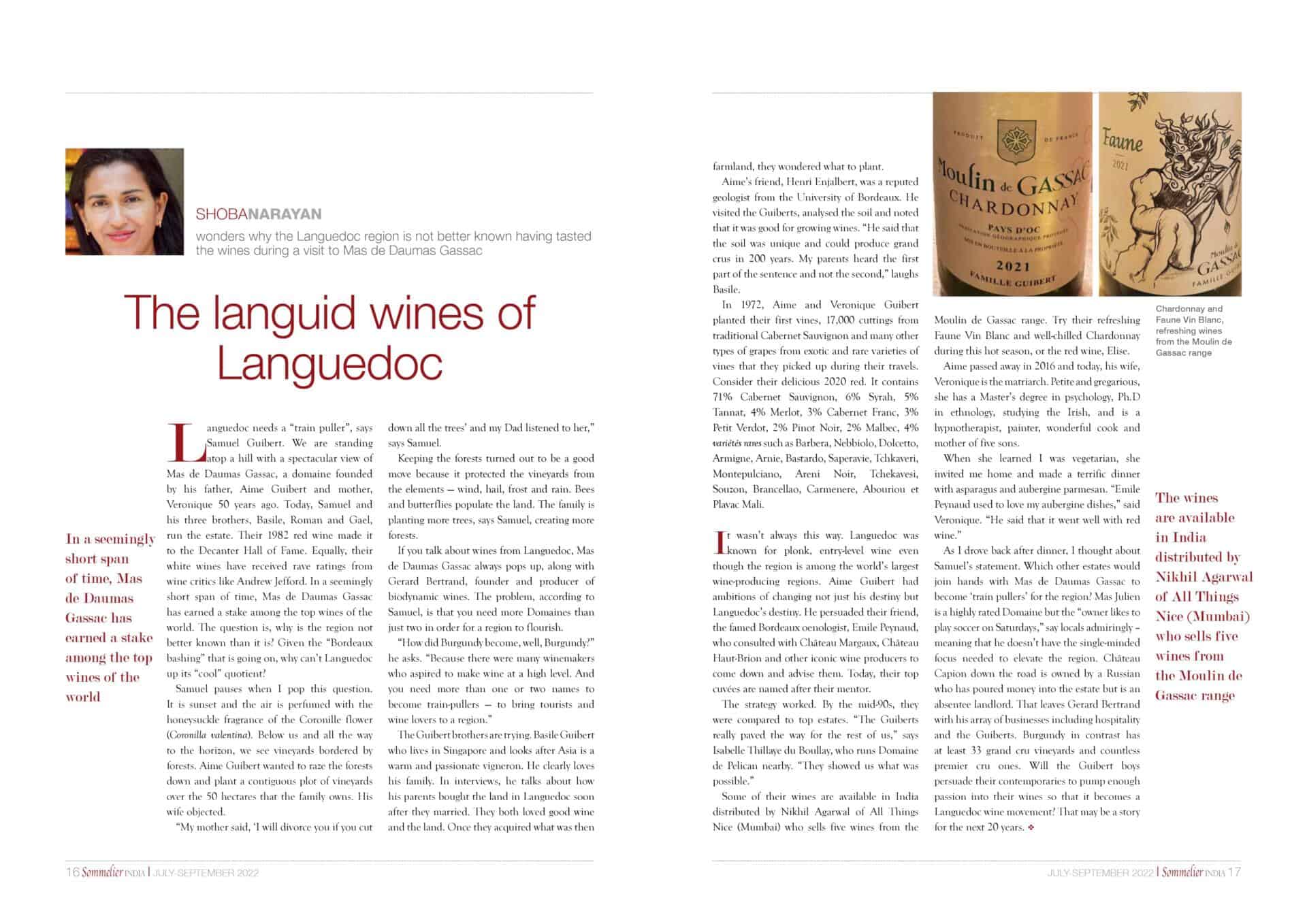For Sommelier India. PDF Here
Languedoc needs a “train puller,” says Samuel Guibert. We are standing atop a hill with a spectacular view of Mas de Daumas Gassac, a domaine founded by his father, Aime Guibert and mother, Veronique fifty years ago. Today, Samuel and his three brothers– Basile, Roman and Gael– run the estate. Their 1982 red made it to the Decanter Hall of Fame. Equally, their white wines have received rave ratings from wine critics like Andrew Jefford. In a seemingly short span of time, Mas de Daumas Gassac has placed a stake among the top wines of the world. The question is: why isn’t the region more well known than it is? Given the “Bordeaux bashing” that is going on, why can’t Languedoc up its “cool” quotient?
Samuel pauses when I pop this question. It is sunset and the air is perfumed with the honeysuckle fragrance of the Coronille flower (Coronilla valentina). Below us and all the way to the horizon, we see vineyards bordered by forests. Aime Guibert wanted to raze the forests down and plant a contiguous plot of vineyards over the 50 hectares that the family owns. His wife objected.
“My mother said, ‘I will divorce you if you cut down all the trees’ and my Dad listened to her,” says Samuel.
Keeping the forests turned out to be a good move because it protected the vineyards from climate elements– wind, hail, frost and rains. Bees and butterflies populate the land. The family is planting more trees, says Samuel, creating more forests.
If you talk about wines from Languedoc, Mas de Daumas Gassac always pops up, along with Gerard Bertrand. The problem, according to Samuel is that you need more domaines than just two in order for a region to flourish. “How did Burgundy become, well Burgundy?” he asks. “Because there were many winemakers who aspired to make wine at a high level. And you need more than one or two names to become train-pullers– to bring tourists and wine-lovers to a region.”
The Guibert brothers are trying. Basile Guibert who lives in Singapore looks after Asia. Some of their wines are available in India through the distributor, All Things Nice (Nikhil Agarwal)– who sells five wines from the Moulin de Gassac range. Try having their chilled refreshing Elise, Faune or Chardonnay during this hot season.
Basile Guibert is a warm and passionate vigneron who clearly loves his family. In interviews, he talks about how his parents bought the land in Languedoc soon after they married. They both loved good wine and the land. Once they acquired what was then farmland, they wondered what to plant. Aime’s friend, Henri Enjalbert, was a reputed geologist from the University of Bordeaux. He visited the Guibert, analysed the soil and said that it was good for growing wines. “He said that the soil was unique and could produce grand crus in 200 years. My parents heard the first part of the sentence and not the second,” laughs Basile.
In 1972, Aime and Veronique Guibert planted their first vines: 17,000 cuttings from traditional ancient cabernet sauvignon and many other types of grapes from exotic and rare varieties of vines that they picked up during their travels. Consider the lineup of their delicious 2020 red. It contains 71% Cabernet Sauvignon, 6% Syrah, 5% Tannat, 4% Merlot, 3% Cabernet Franc, 3% Petit Verdot, 2% Pinot Noir, 2% Malbec, 4% variétés rares : Barbera, Nebbiolo, Dolcetto, Armigne, Arnie, Bastardo, Saperavie, Tchkaveri, Montepulciano, Areni Noir, Tchekavesi, Souzon, Brancellao, Carmenere, Abouriou et Plavac Mali. Earlier vintages contain similar combinations and always contain unique and rare grapes.
It wasn’t always this way. Languedoc was known for plonk wine, entry-level wine even though the region is among the world’s largest wine-producing regions. Aime Guibert had ambitions of changing not just his destiny but Languedoc’s destiny. He persuaded their friend, the famed Bordeaux oenologist, Emile Peynaud, who consulted with Margaux, Haut-Brion and other names to come down and advise them. Today, their top cuvees are named after their mentor.
The strategy worked. By the mid-90s, they were compared to top estates. “The Guiberts really paved the way for the rest of us,” says Isabelle Thillaye du Boullay, who runs Domaine de Pelican nearby. “Showed us what was possible.”
Aime passed away in 2016 and today, his wife, Veronique is the matriarch. Petite and gregarious, she has a Master’s in psychology, Ph.D in ethnology– studying the Irish people– is a hypnotherapist, painter, wonderful cook and has raised five sons.
When she learned I was vegetarian, she invited me home and made a terrific dinner with asparagus and aubergine or eggplant parmesan. “Emile Peynaud used to love my aubergine dishes,” said Veronique. “He said that it went well with red wine.”
As I drove back after dinner, I thought about Samuel’s statement. Which other estates would join hands with Mas de Daumas Gassac to become train pullers for the region? Mas Julien is a highly rated domaine but the “owner likes to play soccer on Saturdays,” say locals admiringly– meaning that he doesn’t have the single-minded focus needed to elevate the region. Chateau Capion down the road is owned by a Russian who has poured money into the estate but is an absentee landlord. That leaves Gerard Bertrand with his array of businesses including hospitality and the Guiberts. Burgundy in contrast has at least 33 grand cru vineyards and countless premier cru ones. Will the Guibert boys persuade their contemporaries to pump enough passion into their wines so that it becomes a Languedoc wine movement? That may be the story for the next twenty years.


Languedoc
This remote and ancient region is fast becoming a wine destination




Leave A Comment